Reversing a district court finding of indefiniteness under 35 U.S.C. § 112 ¶ 6, the US Court of Appeals for the Federal Circuit found that the district court erred by ignoring unrebutted evidence that the challenged claim terms would have been understood to connote sufficiently definite structure to avoid means-plus-function construction. Dyfan, LLC v. Target Corp., Case No. 21-1725 (Fed. Cir. Mar. 24, 2022) (Lourie, Dyk, Stoll, JJ.)
Dyfan sued Target for infringement of two patents directed to location-based message delivery. During claim construction proceedings, Target argued that certain claim limitations should be construed as means-plus-function limitations and that the specification failed to disclose the requisite corresponding structure. The district court found that three claim terms were subject to § 112 ¶ 6. For the terms “code” and “application,” the court assigned a “special-purpose computer function” as the corresponding structure and found that the specification did not disclose a requisite algorithm for the functions of the computer. The district court also found that the claim term “system” was subject to § 112 ¶ 6 because it recited purely functional language without disclosing sufficient corresponding structure, and that it was unclear which of the recited components performed the recited function. The district court concluded that all three terms were indefinite under § 112 ¶ 2 for lack of corresponding structure. Dyfan appealed.
Reviewing de novo, the Federal Circuit first addressed whether the claim language invoked § 112 ¶ 6. As the Court had stated previously, there is a rebuttable presumption that a claim limitation is not drafted in a means-plus-function format if it does not contain the term “means.” However, that presumption can be overcome if a challenger demonstrates that the term fails to recite sufficiently definite structure. The Court also explained that for purposes of § 112 ¶ 6, certain “nonce words that reflect nothing more than verbal constructs” are tantamount to using the word “means.”
Turning to the case merits, the Federal Circuit first considered the terms “code” and “application.” Given the absence of “means” language, Target was required to show by a preponderance of the evidence that persons of ordinary skill in the art would not have understood those terms to connote structure considering the claim as a whole. The Court found that the district court erred in concluding that Target overcame the presumption that § 112 ¶ 6 did not apply. The Court relied on unrebutted testimony from Target’s expert witness that the district court ignored. The expert testified that both terms would have connoted structure, such as off-the-shelf software. The Court found that this unrebutted testimony demonstrated that neither claim limitation recited purely functional language.
The Federal Circuit explained that the district court failed to follow its 2018 decision in Zeroclick v. Apple. In that case, the Court reversed a district court’s finding that the claim terms “program” and “user interface” invoked § 112 ¶ 6, finding that both terms were references to conventional program code existing in the prior [...]
Continue Reading
read more

 Subscribe
Subscribe



